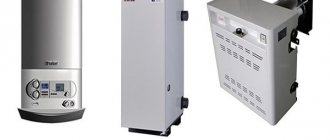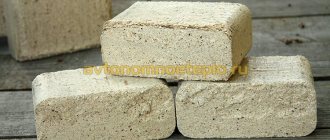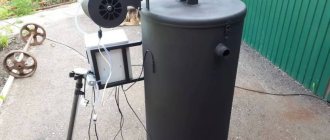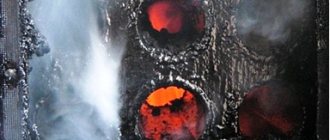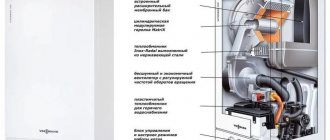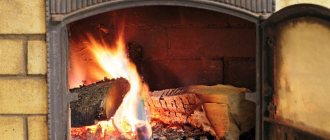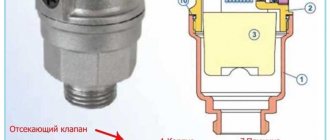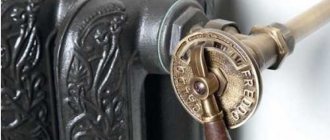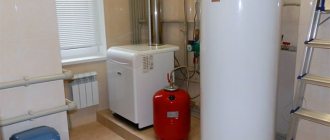Pellets and briquettes are modern types of fuel that are superior to traditional firewood in terms of heat capacity and are optimally suited for boilers with automatic feed.
They can also be burned in conventional heating stoves or boilers, but this method is only effective for briquettes, and for burning with pellets you need a special device - a pellet burner .
In this article we will talk about:
- various heating methods;
- combustion of pellets and briquettes;
- features of heating with pellets and briquettes;
- boilers with automatic fuel supply;
- features of the choice of boilers for heating with briquettes and pellets.
Methods of heating houses
All heating methods can be divided into:
- fuel combustion method;
- method of transferring thermal energy.
There are only 3 ways to burn fuel:
- Traditional , in which the fire spreads from bottom to top (the same method is implemented in boilers with automatic fuel loading).
- Pyrolysis , that is, the decomposition of wood into a minimum amount of ash and pyrolysis gases, which are then burned in a special chamber. Read more about pyrolysis and differences from other methods of burning wood in the article “Pyrolysis gas and its application.”
- Top combustion , in which the fire moves from top to bottom, read more about it in this article (Stropuwa boilers).
There are only 2 ways to transfer heat:
- Water heating , including heated floors.
- Direct radiation of heat (furnaces and rough).
How pellets and briquettes burn
Despite the fact that the combustion of pellets and briquettes is based on the process of pyrolysis, that is, the release of flammable gases when wood is heated and their subsequent combustion, these materials burn differently .
Pellets due to:
- small size;
- dense laying
They do not allow air to pass through them well, so the traditional movement of fire from the bottom up is ineffective .
For efficient combustion, it is necessary to either reduce the thickness of the pellet layer placed in the firebox, or use the movement of fire from top to bottom.
You can read more about this combustion process, as well as the equipment for it, in this article.
Reducing the thickness of the pellet layer in the firebox leads to a reduction in their burning time , and therefore the need to frequently add fuel to the stove or boiler.
There are boilers with automatic pellet feeding that completely solve this problem. Pellets are poured into a hopper, from which they automatically enter the firebox. The pellet supply is regulated by automation , which determines the temperature of the coolant (water) or exhaust gases and uses them to estimate the remaining fuel in the firebox.
The combustion of briquettes
depends on their shape .
Rectangular briquettes (RUF, brick) burn in the same way as firewood, that is, the denser they are stacked, the longer they will burn, releasing less heat.
The greater the distance between them, the faster they will burn, releasing more heat.
Regardless of the installation method, the total amount of thermal energy that will be released during the combustion of briquettes is the same .
In contrast, briquettes of the Nestro type (round) burn equally no matter how they are laid , because there is enough space for passage between them:
- air;
- pyrolysis gases.
Briquettes like Piny & Kay burn in the same way - octagonal logs with a through hole in the middle.
Therefore, for ordinary ones:
- ovens;
- fireplaces;
- boilers,
which do not have an automatic fuel reloading system , any type of pellets are effective.
Features of application
The main problem that arises when heating with any solid fuel is that the burning time of one bookmark with maximum efficiency does not exceed 1–2.5 hours . This fully applies not only to firewood or coal, but also to pellets and briquettes.
Therefore, solid fuel heating is implemented in three different ways:
- increase burning time;
- store the released thermal energy;
- use automatic fuel loading systems.
Increased burning time
The burning time of such fuel is increased in two ways:
- burning from top to bottom;
- restriction of air supply.
Combustion from top to bottom is implemented in boilers and furnaces of the “Stropuva” type, however, such devices are very demanding in terms of :
- fuel quality;
- cravings;
- temperature of the returning coolant.
In addition, boilers of this type are not cheap , their average cost is 100 thousand rubles.
Increase in combustion time due to air supply limitation dramatically:
- reduces the efficiency of the boiler or furnace;
- increases fuel consumption.
How to store thermal energy
More efficient systems are those that store thermal energy to then heat the house for a long time.
Such systems include:
- brick kilns;
- fireplaces with rough brick;
- water boilers of excess power with a heat accumulator (TA).
Brick stoves and fireplaces with rough materials store heat due to the high heat capacity of brick . The temperature of the gases inside the furnace reaches 1000 degrees, so during the burning time of one bookmark (1–2 hours), the brick walls store enough heat to heat the house for 12–20 hours.
Coal and wood stoves work well with briquettes, but heating with pellets requires a pellet burner because pellets are not well suited for such devices due to their combustion characteristics.
Excess power boiler with heat storage
Another option for a system that stores heat is an excess power boiler with a water heater .
Excessive boiler power is necessary in order to release enough heat during one fire to heat the house for 50–70 hours.
In this case, the capacity of the heat accumulator is determined by the formula V=S/10, where:
- V – area of the house in m2;
- S – TA volume in m3.
The boiler power for a well-insulated house is determined by the formula P=S/2, where:
- P – boiler power in kW;
- S – area of the house in m2.
Such systems work well on any type of fuel , so pellets and briquettes have no advantages, except that these materials are cheaper than any other fuel.
also no advantage when using conventional or pyrolysis solid fuel boilers, in which it is necessary to add fuel after 2–6 hours .
However, any of the described systems works well on pellets or briquettes, so the cost of fuel decides everything .
Automatic fuel loading systems
Pellets and briquettes are most effective in boilers with automatic fuel supply . Despite the fact that some models of such boilers can run on wood or coal, pellets and briquettes are preferable. Pellets because of their small size, and briquettes because they have the same shape.
All systems of this type can be divided into:
- pneumatic;
- screw;
- conveyor;
- elevators;
- monoblock.
Pneumatic
Pneumatic systems combine forced air supply to the combustion zone and fuel supply, therefore they are only suitable for boilers operating on:
- pellets;
- wood chips
In such systems, exhaust gas temperature sensors are installed that determine the intensity of combustion.
Therefore, the amount of air and fuel supplied over a period of time is precisely dosed to ensure the most efficient combustion .
During warming up, the amount of air and fuel is maximum, so a strong fire burns in the firebox.
When the temperature in the house has reached the set value, the automation reduces the supply of fuel and air, due to which the boiler switches to low power mode and maintains the temperature .
In pneumatic systems, the boiler and compressor are connected by a thick pipe, the diameter of which is sufficient for the free passage of pellets in any position.
In this case, the diameter depends on the power of the boiler, because even in temperature maintenance mode, the speed of air movement in the pipe must be sufficient to transport fuel .
A dosing device installed under the hopper regulates the fuel supply by changing the cross-section of the hole through which pellets fall into the air duct. On some models, instead of a hole with a variable diameter, a screw drive is installed, providing more precise adjustment .
The main disadvantage of pneumatic systems is their large size, because the pipes take up a lot of space. Therefore, they are installed only in certain rooms. In addition, the boiler can be installed in one room, and the bunker and compressor in another.
Screw
Screw automatic fuel supply systems operate on the same principle as a screw in a meat grinder . A rotating screw moves material from the hopper to the firebox.
By turning the engine on and off, as well as changing its rotation speed in high-power boilers, the supply of fuel to the furnace is regulated.
Such devices are much more compact than pneumatic ones, because in most cases the bunker and boiler are combined into one device. The exception is high-power boilers ; bunkers for them are installed separately and connected to each other by a screw conveyor.
Depending on the firebox model, the screw conveyor delivers pellets either directly into the combustion zone or into the upper part of the firebox, from where the pellets fall into the combustion zone.
In both cases, the hole through which the fuel enters the boiler is closed by a metal valve controlled by an electric motor or solenoid. Therefore, the hole opens only during fuel loading , after which it closes hermetically.
This system protects burning fuel from excess air and also prevents smoke from entering the room.
Boilers with a screw feed are in maximum demand, because without modification or changing settings they can operate not only on pellets, but also on such types of fuel as:
- wood chips;
- sawdust;
- crushed biomass;
- peat;
- black and brown fine coal.
Conveyor
In such systems, the bunker and firebox are connected by a conveyor with:
- tape;
- mesh;
- trays.
The advantage of systems of this type is the ability to supply fairly large fragments to the boiler, which is beyond the capabilities of pneumatic and screw systems, so they are used for boilers operating on:
- coal;
- firewood;
- briquettes.
Due to the fact that firewood and coal consist of fragments of different sizes, difficulties arise with dosing , so in addition to the conveyor, it is necessary to install a complex and expensive loading device.
Briquettes do not have this drawback, therefore, to work with the conveyor, they use the simplest cassette storage facilities, in which the briquettes are stacked in neat and even cassettes.
In such systems, briquettes are first selected from the furthest cassette, then moved to the front, and all this does not require any complex automation .
However, the conveyor system is very poorly suited for pellets, because it is necessary to install a complex loading device based on an auger , and also use not a metal mesh or trays, but a rubber band, which is sensitive to high temperatures.
Therefore, such a system can only deliver pellets to the top of the boiler, where the temperature is not too high, then the pellets will fall into the combustion zone.
This loading method leads to the release of a large amount of combustion products, so the boiler cannot be used in residential buildings or in areas where people are often present.
Elevators
Loading systems of this type are most often used for wood-fired boilers. The elevator lifts the fuel, and the guide located on top sends the top layer of fuel into the boiler.
Such systems can also be used for heating with briquettes, because the guide will send them into the firebox in the same way as firewood.
The main disadvantage of systems of this type is the very high price, therefore for briquettes in which each log corresponds to one:
- form;
- size,
It makes no sense to use such complex and expensive systems.
Monoblock
This is the most popular way to use pellets in boilers of small (up to 50 kW) power.
A bunker is installed above the boiler, which contains enough fuel for heating at maximum mode for at least a day.
After the sensors detect a decrease in the temperature of the exhaust gases, an electric motor or solenoid opens the valve between the boiler and the bunker for a strictly defined time .
Thanks to this, a certain volume of pellets is poured into the firebox, necessary to release the required amount of thermal energy.
All calculations are performed by a built-in processor , which evaluates many parameters and supports combustion in the selected mode.
Automatic cleaning of the firebox and grate
However, automatic fuel reloading is not the only problem that needs to be solved to increase the boiler operating time from one fill, because sawdust and briquettes leave behind ash, which reduces the air supply from below to the combustion zone .
Therefore, automatic ash removal is necessary:
- firebox;
- grate.
To do this, the grate is connected to a vibrator based on:
- electromagnet;
- electric motor.
Based on a signal from the processor, the vibrator pulls the grate, the ash spills down, and the coals and burning fuel remain on the grate .
The same systems are used on any automatic solid fuel boilers, regardless of the type of fuel they operate on.
Current pellet quality standards (2021)
| Characteristics of pellets | ENplus A1 (premium) | ENplus A2 (standard) | ENplus B (industrial) |
| Origin and source of receipt | 1.1.3 Wood trunks 1.2.1 Chemically untreated wood waste | 1.1.1 Whole trees without root system 1.1.3 Tree trunks 1.1.4 Logging waste 1.2.1 Chemically untreated wood waste | 1.1 Forest trees, plantations and other natural wood 1.2 By-products and waste from the wood industry 1.3.1 Untreated waste wood |
| Diameter, mm | 6±1 or 8±1 | ||
| Length, mm | 3,15 1) | ||
| Humidity, % | ≤ 10 | ||
| Ash content, % | ≤ 0,7 | ≤ 1,2 | ≤ 2 |
| Mechanical strength,% | ≥ 98 | ≥ 97,5 | |
| Net calorific value, kW/kg | ≥ 4.6 (≥16.5 MJ/kg) | ||
| Bulk density, kg/m3 | 600 ≤ BD ≤ 750 | ||
| Additives, % | ≤ 2 2) | ||
| Content of small particles less than 3.15 mm (dust), % | ≤ 0,5 3) / ≤ 1,0 4) | ||
| Nitrogen content (Nitrogen N), % | ≤ 0,03 | ≤ 0,05 | ≤ 1,0 |
| Sulfur content (Sulfur S), % | ≤ 0,04 | ≤ 0,05 | |
| Chlorine Cl content, % | ≤ 0,02 | ≤ 0,03 | |
| Arsenic content (Arsenic Ar), mg/kg | ≤ 1,0 | ||
| Cadmium content (Cadmium Cd), mg/kg | ≤ 0,5 | ||
| Chromium content (Chromium Cr), mg/kg | ≤ 10 | ||
| Copper content (Copper Cu), mg/kg | ≤ 10 | ||
| Lead content (Lead Pb), mg/kg | ≤ 10 | ||
| Mercury content (Mercury Hg), mg/kg | ≤ 0,1 | ||
| Nickel content (Nickel Ni), mg/kg | ≤ 10 | ||
| Zinc content (Zinc Zn), mg/kg | ≤ 100 | ||
| Pellet temperature during loading, °C | ≤ 40 | ||
1) - A maximum of 1% of pellets can be longer than 40mm, but the length cannot be more than 45mm. 2) - The amount of additives in production should be limited to 1.8%, the amount of post-production additives (for example, coating oils) should be limited to 0.2% of the weight of the granules. 3) - At the manufacturer, when filling pellet bags or sealed Big Bags. 4) — At the manufacturing plant or upon loading to the end user.
Options for using pellets
Wood pellets are used for the following purposes:
- heating of residential, warehouse and industrial premises; pellet boilers and fireplaces are used as heat sources;
- pet litter;
- bedding for horses;
- bulk base in enclosures and cages of rodents, chinchillas and other small pets;
- raw materials for growing mushrooms;
- removal of technical fluids in auto repair shops.
You can also read: For those who are undecided on choosing a solid fuel boiler, we recommend reading a review article about new generation solid fuel boilers.
How to choose automatic boilers
Since automatic boilers are the most convenient , we will give recommendations that will help you choose the right boiler.
Here is a list of recommendations:
- select the fuel type;
- determine the boiler power;
- determine the cost limit;
- choose a boiler by fuel type, power and price.
Selecting a boiler based on fuel type is necessary because briquette boilers are difficult to adapt to operate on pellets and vice versa .
Therefore, determine what type of fuel you need:
- more accessible;
- costs less.
Read more about the characteristics of pellets and briquettes, as well as their production technology, in this article.
After this, determine the boiler power taking into account:
- squares;
- insulation;
- heating method.
For automatic boilers, a heat accumulator is not required , so their power is calculated using the formula P = S/10, where:
- P – boiler power in kW;
- S – area of the house in m2.
This formula is used only for well-insulated houses . If the house is without insulation, then the boiler power must be increased.
Only a heating engineer with experience working with heating systems can make more accurate calculations.
After this, determine the financial limit for the purchase of a boiler , because the cost of automatic devices, depending on the manufacturer and power, is 60–400 thousand rubles.
Price
We have compiled a table of the most popular models of automatic boilers that can operate on pellets and briquettes made from pressed sawdust:
| Model | Fuel type | Power, kWt | Description | Price (thousand rubles) | Manufacturer or seller website |
| Metal-Fach SEG BIO- 19 kW | Pellets | 19 | Polish automatic pellet boiler of low power. It can also work on fine coal (automatic mode), coarse coal, firewood and briquettes (manual loading). | 227 | heat-trend.ru |
| Vulkan EKO-24 kW | Pellets | 24 | Russian automatic pellet boiler of low power. It is possible to order with a larger hopper, which will extend the life of one load of fuel. Due to the large volume of the ash pan, it can be cleaned simultaneously with loading fuel with any bunker volume allowed for this model. | 167 | heat-trend.ru |
| Faci 51 | Pellets | 51 | Italian medium power boiler with screw drive. The bunker volume is up to 400 liters, you can choose when ordering the boiler. Equipped with an automatic ash removal system. | 269 | biensi.ru |
| Teplodar Kupper OK 20 | Pellets | 20 | Russian pellet boiler with screw feed. Hopper volume 240 liters. | 85 | teplosvarka.ru |
| Forester | Briquettes, firewood | 15 | Automatic conveyor boiler for working with briquettes and wood. Power is controlled by the fuel supply rate. The boiler is made to order. | 65 | snab23.ru |
| Svetlobor VD 16 | Pellets | 16 | Russian automatic boiler with pneumatic supply of pellets. All systems in which dust, dirt, soot or ash may accumulate are automatically cleaned. | 219 | svetlobor.com |
The best semi-automatic machines
Heiztechnik Q BIO DUO 35
Country of origin: Italy. Average cost – 190 thousand rubles. The model is equipped with a double firebox. Efficiency – 88%. The unit can operate in automatic and manual mode.
In addition to the burner, the structure is equipped with a grate for storing firewood. The pellet machine can work offline for 3 days. Designed for heating rooms up to 350 square meters. m.
Advantages:
- high degree of security;
- ability to work on pellets and firewood;
- convenient display of the control unit;
- spacious fuel hopper (300 l),
Flaws:
- large dimensions;
- high price.
Review
| Roman I. |
| You cannot heat a boiler with coal. The slag is sintered on the burner. It hangs on it like a big cake. You have to constantly clean them. |
Kiturami KRP 20A
Country of origin: South Korea. Average cost – 200 thousand rubles. The model is designed for heating houses up to 300 square meters. m. The design is equipped with an auto-ignition system. When granules burn, a lot of ash is formed, which must be constantly removed from the ash pit. The boiler has a fire extinguishing function. Fuel combustion modes are set on the control unit, but pellets must be filled in manually. Efficiency 92%.
Advantages:
- high degree of security;
- automatic diagnostics.
Flaws:
- the model does not have a circulation pump;
- no heating indicator;
- heavy weight.
Review
| Marina G. |
| The boiler has to be cleaned frequently. I do this at least once a week. |
ACV ECO Comfort 25
Country of origin: Belgium. Average cost – 250 thousand rubles. The model has automatic ignition. The fuel hopper can be fixed in the right or left-hand position. The combustion chamber is made of stainless steel. The burner is cast iron.
Advantages:
- ease of connection to the heating system;
- good thermal insulation.
Flaws:
- heavy weight;
- Suitable only for a certain type of pellet.
Review
| Yulia K. |
| Nice build. Reliable unit. |
Other types of boilers
Among other types of boilers suitable for working with pellets and briquettes, the most popular are models with top combustion .
Their advantage is that such a boiler can operate for 20–60 hours on one load of fuel.
The downside is that they reach full power in 15–25 hours, depending on:
- type of fuel;
- its burning rate.
Another serious drawback is the high price, comparable to automatic pellet boilers, which reach full power within 1–2 hours.
Another popular type of boiler is pyrolysis, in which fuel burns under conditions of severe oxygen deficiency . This leads to the release of a large amount of pyrolysis gases, which are then burned in a special chamber.
Thanks to this combustion method:
- boiler efficiency increases;
- fuel consumption is reduced.
The burning time of one load of fuel is 3–7 hours.
They are more efficient when working on briquettes due to the characteristics of the movement:
- air;
- pyrolysis gases
in the firebox and afterburner.
The third type of boilers is classic and extremely simple devices. Their only advantage is their low price ; the cheapest models can be bought for 5–15 thousand rubles.
The efficiency of such boilers is 75–80 percent, which is noticeably lower than that of any other type of boiler. Therefore, they are used only as a temporary heat source while waiting for the delivery of a normal boiler. The burning time of one load of fuel in them is 1.5–2.5 hours.
Technological process for making granules
Coarse crushing. Crushing machines are used to grind sawdust into flour. Then the material is dried until it reaches 10% humidity, for which special drums are used.
Second grinding. Hammer mills crush raw materials to a maximum size of 6 mm.
dried until it reaches 8-10% humidity in drum or belt dryers.
Pressing. The raw materials are heated to 120 °C and subjected to pressure from a special granulator press. Typically this machine uses several types of dies:
- cylindrical;
- flat;
- roller;
- screw
This miniature granulator press has a productivity of up to 250 kg/hour.
Cooling . This process is performed as needed.
Packaging. According to calculations, to obtain one ton of pellets, you need to have 2.5 m³ of sawdust. Household pellets are packaged in bags with a maximum weight of 30 kg. Such packaging with industrial granules can weigh up to 1000 kg.
A small line, which is based on the OGM-1.5, costs approximately $55,000. The price of industrial equipment will be much higher. In this case, performance comes first:
- 700 kg/h – $132,000;
- 2000 kg/h – $196,000.
Thermal accumulators
All boilers of these types are effective only when connected to a heat accumulator , otherwise the boiler will have to be fired several times a day:
- clean;
- download;
- melt.
Due to the high cost of the TA and the cost of its installation, even the cheapest boiler will cost several times more than the average cost automatic boiler.
For a house with an area of 100 m2, the optimal capacity of the heat accumulator is 10 m3.
The TA must be installed below floor level; if it leaks, there is a high probability of severe burns.
Reducing the TA capacity leads to a reduction in heating time , so it is undesirable to reduce its volume by more than 3 times.
For example, a heat exchanger with a capacity of 3 m3 can heat a well-insulated house with an area of 100 m2 for 20–25 hours, even in severe frosts. That is, the boiler will have to be heated once a day.
If the capacity of one heat accumulator is not enough, then several heat accumulators are installed, using different connection schemes; this does not change the heating time of the house .
Here is the approximate cost and a brief description of heat accumulators, as well as various types of boilers for working with them:
| Thermal accumulators | |||||
| Model | Volume, m3 | Height and diameter in cm | Description and characteristics | Price thousand rubles | Website |
| TR 4500 | 3,5 | 230/160 | The tank is made of stainless food steel grade 08Х18Н10, wall thickness 3-5 mm, maximum pressure 9 bar, externally insulated with mineral wool or polystyrene foam (as agreed with the customer). Installation of heat exchangers is possible. | 597 | profbak.rf |
| Alfa 1000 l | 1 | 210/99 | Heat accumulator with built-in heat exchanger. The body is made of carbon steel, the heat exchanger is made of stainless steel. The outside of the case is covered with polyurethane insulation, the protective layer is made of plastic. | 216 | krasnodar.sol-battery.ru |
| PSRR 5000 | 5 | 285/180 | Steel tank with heat exchanger. Insulation must be purchased separately. The maximum pressure in the tank is 3 bar, in the heat exchangers 10 bar. | 445 | klimatabogi.ru |
| Galmet Buffer 1500 | 1,5 | 270/110 with insulation, 270/90 without insulation | Steel tank with heat exchanger. Insulation must be purchased separately. The maximum pressure in the tank is 3 bar, in the heat exchangers 10 bar. | 99 | mirtepla43.rf |
| Heatleader MB 10000 AN | 10 | 415/220 | Tank made of stainless or carbon steel, with 10 cm thick insulation and stainless steel heat exchangers. A temperature indicator is installed on the tank body. | 1600 | bigboilers.ru |
| Heating boilers | |||||
| Model | Power, kWt | Boiler type | Description and characteristics | Price thousand rubles | Website |
| Don KS-T-11 | 11 | Classical | Inexpensive boiler for all types of solid fuel, efficiency 82%. | 12,5 | mir-kotlov.com |
| T-30 | 30 | Classical | Classic floor-standing boiler for all types of solid fuel, efficiency 82%. | 65,9 | |
| VIKING K-WRM 18R | 18 | Classical | A classic solid fuel boiler with a gas afterburning system that increases efficiency. | 128 | heat-as.ru |
| Suvorov 20k | 23 | Classical | A classic solid fuel boiler with a gas afterburning system that increases efficiency and combustion time. | 59 | pechi-troyka.ru |
| VELES 8EVT | 8 | Classical | Classic solid fuel boiler with a gas afterburning system. | 24 | veleskotel.ru |
| Burzhuy-K Modern 12 | 12 | Pyrolysis | Pyrolysis (gas generator) boiler with automatic control. Efficiency 82-92%. The firebox is made of steel without lining. | 63 | teplina-nsk.ru |
| BTS Standard 15 | 15 | Pyrolysis | Pyrolysis (gas generator) boiler with automatic control. Efficiency 86-92%. Ceramic firebox. | 128 | oasistepla.ru |
| Vitoligno 100s | 25 | Pyrolysis | Pyrolysis (gas generator) boiler with automatic control. Efficiency 86-92%. The firebox is lined with refractory bricks. | 168 | kotlydlyadoma.ru |
| Taiga 15 kW | 15 | Top burning | Top combustion boiler with automatic mode control. Made of steel 09g2s with a thickness of 6 mm. The grates are cooled with water and do not burn out much longer than on boilers of other models. | 88 | katalogtepla.ru |
| STROPUVA MINI S8 | 8 | Top burning | Top combustion boiler with automatic mode control. Manufactured under the supervision of Stropuva. | 60 | buyboilers.rf |
| Flamemap | 20 | Top burning | Top combustion boiler with automatic mode control. Manufactured based on the design of original Stropuva boilers. | 50 | https://flameup.ru/ |
Pellet burners
Conventional solid fuel boilers are not very well suited for burning pellets, so they are converted by inserting a pellet burner .
The same modification can be made with floor-standing gas boilers, because the output of the burner produces a flame with a small amount of smoke.
The burner includes:
- pellet hopper;
- feeding system (most often screw);
- a safety hose separating the hopper and auger feed from the burner;
- burner;
- lambda probe, which evaluates the amount of oxygen in the exhaust gases and determines the combustion mode of pellets (not installed on all devices);
- Remote Control.
With the help of such burners, you can adapt most not only solid fuel, but also liquid fuel or gas boilers to work on pellets.
As a result, you will only:
- pour pellets into the bunker;
- remove ash;
- periodically clean the burner,
the burner automation will do the rest.
can also , including those equipped with coarse kilns.
Here is the cost and a brief description of the most popular models of such burners:
| Brand | Power, kWt | Description | Price thousand rubles | Manufacturer or seller website |
| Pelletron-15MA | 15 | Semi-automatic burner with a small capacity hopper. The burner must be cleaned once a day. The fuel is ignited manually. The door for installation in the boiler must be purchased separately, choosing it according to the size of the boiler. | 18 | pelletron.ru |
| RV10/20 | 50 | Automatic burner for boilers such as Peresvet, Valdai, YaIK, Don and others, which have the same size of firebox and door. Automatic ignition of pellets. Automatic pneumatic cleaning, so the burner can operate for several weeks without maintenance if there is enough fuel. Thanks to temperature sensors, the control unit automatically changes the burner operating mode. | 93 | heat-trend.ru |
| Terminator-15 | 15 | Automatic burner for burning any pellets. Thanks to the self-cleaning function, it can work without maintenance for 14 days. It is equipped with a GSM unit, so the burner operating mode can be controlled from a phone or tablet, as well as receive information about its operating mode. | 74 | teplohorosho.ru |
| Pelltech PV 20b | 20 | Fully automatic burner with electric pellet ignition. Thanks to the self-cleaning function, it requires maintenance 2-3 times a month. Independently regulates the flame strength, ensuring the desired coolant temperature. When there is a power outage, it switches to a backup battery. | 97 | bio-nik.ru |
How to choose
When choosing pellet burners, you must first pay attention to compliance with the boiler, because some burners are produced for specific boiler models, for others you can purchase adapter doors that match a particular boiler.
The second important parameter is power, because maximum burner efficiency is achieved only when operating at full power .
After this you need to determine:
- pellet type;
- operating time from one load;
- time between services;
- bunker volume;
- cost limit.
Most automatic burners work well with any pellet, but units that are not equipped with a self-cleaning function are suitable for use only if you use white hardwood granular sawdust.
The operating time from one load should not be less than 24 hours in maximum power mode. Otherwise, in severe frosts, automatic burners will lose their advantage over conventional boilers.
The average fuel consumption in most burners is 200–250 grams per 1 kW of boiler power per hour. From this formula the required volume of the bunker is determined .
Burners without self-cleaning are inexpensive, but they have to be cleaned every day , so they are seriously inferior to automatic ones.
Therefore, you have to choose: take either an inexpensive burner that needs to be cleaned every day, or an expensive one that requires maintenance only once every 2 weeks.
Popular models
The most famous suppliers of solid fuel units are the following brands:
- Lithuanian Stopuva;
- German Buderus;
- Czech Wattek;
- Belgian ACV;
- Austrian Wirbel;
- Russian NMK, Zota and TeploGarant LLC.
Among the models on the market from various companies, there are several popular devices.
Stropuva Mini S8
A power-independent unit serving an area of up to 80 square meters. m. Works with three types of fuel and is distinguished by its small size. Equipped with a convenient vertical firebox door.
The special design of the ash pan allows you to reduce the need to clean it to twice a month. One bookmark is enough for daily heating; the pellets burn out in 48 hours.
Advantages:
- high efficiency;
- quality of construction;
- safety;
- presence of a thermometer.
Flaws:
- heavy weight;
- The rough surface of the door makes it difficult to clean.
| Roman Oborin: | Igor Falaev: |
| “Economical and compact unit, burns for a long time. It consumes little fuel, heats the house well, and does not produce soot. The only negative is that it’s a bit heavy.” | “A small, convenient barrel, the device is immediately ready for use, you don’t need to assemble or screw anything in. The door handles are of high quality and reliable, they do not open spontaneously. It takes a long time to heat, it can burn for up to 20 hours.” |
Teplodar Cooper Expert-15
Russian model with the ability to install a burner.
In the upper half of the housing there is a fitting for air outlet. Compatible with firewood, coal and briquettes. Three air entry zones and top combustion ensure long-term heat maintenance. At the bottom there is a water reservoir that prevents excessive heating of the floor. A steel plate protects the door from heat. You can additionally attach a draft regulator.
Advantages:
- possibility of installing a pellet or gas burner;
- convenient door placed at an angle;
- continuous burning for 24 hours.
Flaws:
- complexity of installation;
- small firebox.
| Oleg Egorin: | Semyon Ivin: |
| “It’s a convenient boiler, you can buy an additional burner, it works for a long time and even after switching off the house remains warm.” | “It’s not a bad unit, it’s enough for almost a day of heating, but it consumes a lot of fuel. Convenient door design for stowage." |
ZOTA Topol-16VK
A device with a water circuit at an affordable price. The triangular shape of the pipe avoids blockages and increases the service life of the device. To refuel the boiler, you can use firewood, coal and pellets.
The model is distinguished by a spacious firebox and the possibility of top and side fuel storage.
Advantages:
- low price;
- ease of use and cleaning;
- efficiency.
Flaws:
low efficiency.
| Vladimir Kharitonov: | Alexey Zaitsev: |
| “A high-quality device at an affordable price for its segment. Works flawlessly." | “The device is pleasant to use, cleans without problems, you can load different types of fuel, both briquette and regular.” |
Teplodar Cooper Expert-22
The device is small in size, capable of operating in 4 modes: fast heating, classic, medium and maximum.
Combustion from top to bottom ensures uniform and longer combustion of the material and good heat transfer. The upper cleaning hatch is protected by a steel screen that prevents burning.
Advantages:
- two hatches for cleaning;
- inclined door for top loading;
- top burning function.
| Evgeny Zherdev: | Ivan Alaev: |
| “Sophisticated heating adjustment, you can adjust the burning duration from 30 minutes to a day. Easy to clean, special cleaning accessories included.” | “A high-quality model, the design allows you to connect heating pipes from either side. The device comes with a heating element and a thermomanometer.” |
Stropuva S30
Solid fuel boiler for placement in commercial and residential premises. Equally effective for year-round and seasonal use. It is characterized by high efficiency, is independent of power supply and is compatible with a variety of fuel materials.
The device has compact dimensions and is environmentally friendly. The duration of firewood burning is up to 30 hours, briquettes can smolder for up to 2 days.
Advantages:
- safety of use;
- high efficiency;
- durability;
- build quality.
Flaws:
high price.
Homemade heating devices
On numerous forums, users:
- talk about independent production of pellet and briquette stoves and boilers (including those with automatic fuel supply);
- discuss the experience of their use.
Therefore, we offer you several links to the most authoritative forums and related topics:
- Forumhouse: Automatic solid fuel boiler using briquettes.
- WoodMaster: Homemade pellet burner and hopper.
- Metal forum: Pellet stove with boiler.
Conclusion
Pellets and briquettes are modern types of fuel that are superior to firewood in terms of heat capacity, and coal in terms of ease of use.
However, to effectively use this fuel, special equipment is required, because the main advantage of pellets and briquettes is that they can be loaded automatically .
Now you know:
- what equipment is needed for heating using these materials;
- what is the difference between heating devices using pellets and briquettes from conventional solid fuel stoves and boilers;
- how much do heating devices with pellets and briquettes cost;
- how to choose boilers for heating with pellets and briquettes.
Area of use
Pellet boilers have high technical properties. This explains their widespread use in various fields. Today, experts distinguish between two main areas of application for such heaters:
- Industrial enterprises, restaurants, shops and other institutions and buildings that require heating and hot water supply.
- Such boilers are very popular among owners of country houses. With their help, you can create a productive heating system, the maintenance of which does not require large costs.
Before installing a pellet boiler, you need to familiarize yourself with the different types of boilers and choose the best option for yourself.
